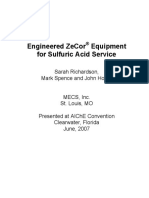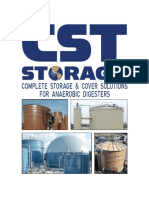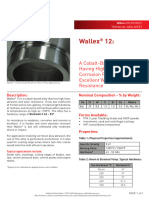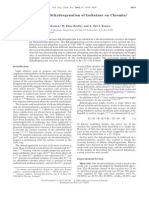101 (2006)
101 (2006)
Uploaded by
Eng-Mahmoud AtiaCopyright:
Available Formats
101 (2006)
101 (2006)
Uploaded by
Eng-Mahmoud AtiaOriginal Title
Copyright
Available Formats
Share this document
Did you find this document useful?
Is this content inappropriate?
Copyright:
Available Formats
101 (2006)
101 (2006)
Uploaded by
Eng-Mahmoud AtiaCopyright:
Available Formats
101
COMPOSITE DUCTILE IRON CASTINGS WITH “CAST IN”
HIGH CHROME WEAR RESISTANT INSERTS
by
Reginald D. Forrest, Sorelmetal Technical Services
There are many service applications where Ductile One solution to these limitations is to produce a
Iron is required to withstand arduous and abrasive composite casting whereby a tough, durable,
conditions. Careful selection of the grade of Ductile machinable grade of Ductile Iron is produced with
Iron is necessary and the RIT publication “Ductile Iron “cast-in” inserts of the required highly alloyed material
Data for Design Engineers” is most useful in this located in the critical areas.
regard.
The Magotteaux Group of Industries whose
The pearlitic grades of Ductile Iron respond well to headquarters are sited in Belgium, has developed and
quench and temper heat treatments as well as patented a unique technique for producing such a
localized induction or flame hardening to provide hard, composite material – called DUOCAST.
wear resistant areas. Chill casting and selection of
alloying, as in the case of Ductile Iron rolls, will further
extend the wear resistance and durability of Ductile
Iron castings. “Double Poured” rolls, where a hard
chilled (carbidic) wear resistant outer layer is
supported by a core of tough, durable Ductile Iron are
frequently used in steel rolling mills – considerable
skill and experience is required to optimize the
structure and performance of double poured Ductile
Iron rolls.
There are some very abrasive service conditions
where only highly alloyed steels or irons can perform
satisfactorily. Such conditions are encountered, for
instance, in cement plants and thermal power stations
where castings are required for grinding coal, Figure 1. Schematic Showing Duocast Rollers in Use in a Loesche Mill.
limestone, slag, clinker and other additives such as
iron ore, pouzzolane, etc... In such situations, highly
alloyed steels or high chrome white irons – often
containing up to 30% chromium together with nickel
and molybdenum – are required to overcome wear
phenomena: thanks to the high hardness of those
special grades. Such hard castings however are more
expensive, difficult to machine and relatively brittle if
not manufactured and installed properly.
Figure 2. Close up Photograph of Duocast Roll in Service.
Duocast wear resistant rollers are now well
established in grinding plants using vertical mills. As
already mentioned above, they consist of a tough
pearlitic Ductile Iron supporting base with specially
designed Magotteaux high chrome iron inserts cast in
at selected locations on the wear areas. The bonding
between both grades is mechanical.
Typical compositions of the base Ductile Iron are 3.35
– 3.4 % C with 1.85% Si and very low levels of P, S,
Cr and other elements which could impair the
necessary toughness characteristics required in the
large backing Ductile Iron casting. Tensile strengths
exceeding 600 N/ mm² (85,000 psi) are looked for. Figure 4. Preparing a Duocast Roller (Composite DI Casting with High Cr.
Great care is taken in the selection of furnace charge Insert) for Installation in a Loesche Mill.
materials in the production of these Ductile Iron
castings and Sorelmetal has proved to be highly Duocast rollers have been widely accepted in vertical
suitable for this application. roller mills – increasing life, mill average capacity and
reducing energy specific consumption. Compared
The high chrome iron inserts are carefully specified with NiHard and other high chrome monometal cast
according to the application requirements. irons, Duocast has a greatly improved fracture
resistance and reliability especially in large grinding
Magotteaux provides a wide range of high chrome mills. As a consequence, reductions in the frequency
solutions, tailor made to the final application. of shutdowns associated with increased lifetimes have
resulted in major operating cost reductions in all
Chrome contents, varying between 12 and 35%, as vertical mill types, such as for instance, Raymond,
well as a superficial final hardness, generally above Loesche, Polysius, Pfeiffer, etc.. mills.
60 HRc, are among the criteria which are studied in
order to achieve the best compromise between cost Duocast technology using high quality Ductile Iron
and expected wear resistance. castings - as achieved with Sorelmetal in the base
charge - with cast in high chromium iron inserts is
Likewise the design of these inserts, in particular the becoming the preferred choice for wear resistant
contoured keying design and the attention given to composite castings in cement plants, thermal power
ensure complete bonding between the Ductile Iron stations and in many general engineering applications.
casting and the inserts (Figure 3), are features of the
Duocast patented technique. Even if small cracks are This is another example of the diversity of uses and
initiated in these special inserts under use, the adaptability of Ductile Iron castings.
integrity of the roller is maintained by the toughness of
the high quality Ductile Iron backing and crack Acknowledgments: Magotteaux International, S.A.
propagation is prevented. Belgium
Figure 3. Schematic Drawing of Insert Design and Contoured Keying to Ensure REV – March 2006
Bonding between DI Casting and High Chrome Insert.
You might also like
- Deep Nitrided 32crmov13 Steel For Aerospace Bearings ApplicationsDocument8 pagesDeep Nitrided 32crmov13 Steel For Aerospace Bearings ApplicationsmvanzijpNo ratings yet
- Instruction Manual: Hand Stacker Pa1015 Capacity 1000kgDocument17 pagesInstruction Manual: Hand Stacker Pa1015 Capacity 1000kgEng-Mahmoud AtiaNo ratings yet
- Sheet Metal Thickness TolerancesDocument16 pagesSheet Metal Thickness TolerancesEng-Mahmoud AtiaNo ratings yet
- En 10051 PDFDocument24 pagesEn 10051 PDFVladNo ratings yet
- Common Metallurgical Defects in Ductile Cast IronDocument10 pagesCommon Metallurgical Defects in Ductile Cast IronsateeshkoriNo ratings yet
- Level 2 Year 5 6 EngDocument8 pagesLevel 2 Year 5 6 EngKarren Cacabelos SurNo ratings yet
- Designing With Ductile IronDocument4 pagesDesigning With Ductile IronCarlos LaoNo ratings yet
- Corrosion Resistance Weld Overlay CladdingDocument4 pagesCorrosion Resistance Weld Overlay CladdingiJordanScribdNo ratings yet
- OSNA10 Sheathing MTL Group EN 2019Document6 pagesOSNA10 Sheathing MTL Group EN 2019David RobsonNo ratings yet
- DramixDocument2 pagesDramixkaadal12No ratings yet
- Thinking Thin With Green Sand Cast IronDocument3 pagesThinking Thin With Green Sand Cast Ironmecaunidos7771No ratings yet
- ESI Grating CatalougeDocument12 pagesESI Grating Catalougevinoj chandranNo ratings yet
- Low Voltage Mining Motors - 440V - 60HzDocument28 pagesLow Voltage Mining Motors - 440V - 60HzMiguel DiazNo ratings yet
- Composite Wear PlateDocument3 pagesComposite Wear PlateChandra SekarNo ratings yet
- Applications of ADI in High Strength Thin Wall Automotive PartsDocument6 pagesApplications of ADI in High Strength Thin Wall Automotive PartsalgobozkurtNo ratings yet
- Chapter 7 Final A5 EditDocument32 pagesChapter 7 Final A5 EditkINGNo ratings yet
- Wear Plate PDFDocument19 pagesWear Plate PDFNorma SalazarNo ratings yet
- Steel in Stadium EgineeringDocument4 pagesSteel in Stadium EgineeringFrans HeidelooNo ratings yet
- Zecor PDFDocument7 pagesZecor PDFjavoidea696526100% (1)
- Welding of Offshore Structure 2012Document17 pagesWelding of Offshore Structure 2012ABDELOUAHEB HAMIDINo ratings yet
- DSM-0279.0 Fe SpecialityDocument3 pagesDSM-0279.0 Fe SpecialityStefanoNo ratings yet
- Cladding & Overlay - Ni InstituteDocument24 pagesCladding & Overlay - Ni Institutesajid aslamNo ratings yet
- Metallurgical Benefits of Vanadium Microalloying in Producing High Strength Seismic Grade RebarDocument12 pagesMetallurgical Benefits of Vanadium Microalloying in Producing High Strength Seismic Grade RebarUlises Quintana Carhuancho100% (1)
- Design: Where Continuous Operation Is Required, Speeds May Be Limited To 107Mpm and Pressure Maximum To 240 KpaDocument30 pagesDesign: Where Continuous Operation Is Required, Speeds May Be Limited To 107Mpm and Pressure Maximum To 240 KpaglobalindosparepartsNo ratings yet
- Ti in FGD ApplicationDocument14 pagesTi in FGD ApplicationAnjan DeyNo ratings yet
- Development of Large-Capacity, Highly Efficient Welded Rotor For Steam TurbinesDocument6 pagesDevelopment of Large-Capacity, Highly Efficient Welded Rotor For Steam Turbinesdzikrie primaNo ratings yet
- Tempcore ProcessDocument23 pagesTempcore ProcessKumaran 1987No ratings yet
- Wear Rate LoescheDocument8 pagesWear Rate LoescheEdson Ricardo Lima100% (2)
- Corus Clad PipeDocument7 pagesCorus Clad PipeDBasak_1974No ratings yet
- Aerospace MaterialsDocument28 pagesAerospace MaterialsSebastian M. PajaroNo ratings yet
- Surfacing of MetalsDocument9 pagesSurfacing of MetalsNixon LionelNo ratings yet
- GSS 008-2020 - WHY CHROME (CR) SHOULD BE BELOW 0.30%Document3 pagesGSS 008-2020 - WHY CHROME (CR) SHOULD BE BELOW 0.30%SANJAY AGARWALNo ratings yet
- Steel Ladle Calderys Brochure A4Document22 pagesSteel Ladle Calderys Brochure A4Mitone Diaz100% (1)
- Wear Plate & Block: Our Innovation. Your AdvantageDocument52 pagesWear Plate & Block: Our Innovation. Your AdvantageWilder Frank Paredes NorabuenaNo ratings yet
- Thermal Analysis of Ductile Iron CastingDocument12 pagesThermal Analysis of Ductile Iron CastingRavisatya DasamNo ratings yet
- RoofDek Structural Roof Decking and Trays BrochureDocument24 pagesRoofDek Structural Roof Decking and Trays Brochuresiddharth vekariyaNo ratings yet
- Shotcrete BrochureDocument6 pagesShotcrete Brochureit4scribdNo ratings yet
- Stainless Steel ClassificationDocument5 pagesStainless Steel Classificationyatin888No ratings yet
- High Carbon Steel Rolling DMHDocument10 pagesHigh Carbon Steel Rolling DMHimtiyaz aliNo ratings yet
- 026 TS Hardox 600 The Ultimate Wear Plate UKDocument4 pages026 TS Hardox 600 The Ultimate Wear Plate UKNguyen Duc DungNo ratings yet
- Steels For Oil - Gas - ExplorationDocument16 pagesSteels For Oil - Gas - Explorationدكتور مهندس جمال الشربينىNo ratings yet
- JSW CRS TMT RebarDocument16 pagesJSW CRS TMT Rebarsri projectssNo ratings yet
- Advantages of Copper Alloy Castings: 1.1. Good CastabilityDocument1 pageAdvantages of Copper Alloy Castings: 1.1. Good CastabilityakmlogaNo ratings yet
- Anaerobic Digester BrochureDocument8 pagesAnaerobic Digester BrochureGrey NghidengwaNo ratings yet
- TQIWPJS0ON 9 Aluminium ExtrusionDocument3 pagesTQIWPJS0ON 9 Aluminium Extrusionlamia97No ratings yet
- High Strength SteelsDocument14 pagesHigh Strength Steelsrabiya.dNo ratings yet
- Modern High Strength Niobium Microallyed Structural SteelsDocument26 pagesModern High Strength Niobium Microallyed Structural SteelsimetallurgyNo ratings yet
- Hammer Development CoalDocument12 pagesHammer Development Coalppd9890No ratings yet
- Ductile Cast IronDocument23 pagesDuctile Cast IronManicharanNo ratings yet
- MCM AllDocument7 pagesMCM AllPalanisamy RajaNo ratings yet
- The Properties of Commercial Aluminum Alloys Depend On The Amount of Magnesium, Copper, Silicon, Chromium and Other Alloying Elements Present in ThemDocument8 pagesThe Properties of Commercial Aluminum Alloys Depend On The Amount of Magnesium, Copper, Silicon, Chromium and Other Alloying Elements Present in ThemHuzaifa AnsariNo ratings yet
- Flooring ENDocument12 pagesFlooring ENYousifNo ratings yet
- Friction Welding of Combat Vehicles at TWI: by Stephan Kallee and Dave NicholasDocument10 pagesFriction Welding of Combat Vehicles at TWI: by Stephan Kallee and Dave NicholasB Vijaya KumarNo ratings yet
- What Is Steel Reinforcement? Why Is It Required in A Concrete Structure?Document11 pagesWhat Is Steel Reinforcement? Why Is It Required in A Concrete Structure?Jesse RodriguezNo ratings yet
- What Is Steel Reinforcement? Why Is It Required in A Concrete Structure?Document11 pagesWhat Is Steel Reinforcement? Why Is It Required in A Concrete Structure?Rabish ANo ratings yet
- Durability of SFRC PDFDocument10 pagesDurability of SFRC PDFBehzadDastjerdyNo ratings yet
- SteelccreteDocument4 pagesSteelccreteOSE0597No ratings yet
- Stel Casting Handbook - Sample PagesDocument5 pagesStel Casting Handbook - Sample PagesBobby WongNo ratings yet
- Drive Comparison 2003Document21 pagesDrive Comparison 2003LTE002No ratings yet
- Wall-Colmonoy Wallex-12 ENG January2021Document3 pagesWall-Colmonoy Wallex-12 ENG January2021pranav kariaNo ratings yet
- Profiled Steel Sheets: Sacrificial Siiuttering (Form Deck)Document2 pagesProfiled Steel Sheets: Sacrificial Siiuttering (Form Deck)Sarmishtha DeNo ratings yet
- Body in WhiteDocument39 pagesBody in WhiteShashank GoudNo ratings yet
- High Strength Steels For Naval ApplicationsDocument19 pagesHigh Strength Steels For Naval ApplicationsRaju NagendraNo ratings yet
- Sheet Metalwork on the Farm - Containing Information on Materials, Soldering, Tools and Methods of Sheet MetalworkFrom EverandSheet Metalwork on the Farm - Containing Information on Materials, Soldering, Tools and Methods of Sheet MetalworkNo ratings yet
- Forging - Manual of Practical Instruction in Hand Forging of Wrought Iron, Machine Steel and Tool Steel; Drop Forging; and Heat Treatment of Steel, Including Annealing, Hardening and TemperingFrom EverandForging - Manual of Practical Instruction in Hand Forging of Wrought Iron, Machine Steel and Tool Steel; Drop Forging; and Heat Treatment of Steel, Including Annealing, Hardening and TemperingRating: 5 out of 5 stars5/5 (1)
- Hydraulic Stacker: Operating Instructions and Parts ManualDocument12 pagesHydraulic Stacker: Operating Instructions and Parts ManualEng-Mahmoud AtiaNo ratings yet
- Resolving Surface Chemical States in XPS Analysis of First Row Transition Metals, Oxides and HydroxidesDocument14 pagesResolving Surface Chemical States in XPS Analysis of First Row Transition Metals, Oxides and HydroxidesCB Dong SuwonNo ratings yet
- Kinetic Modeling PFR - FluidizedDocument8 pagesKinetic Modeling PFR - FluidizedTeo Han ChuinNo ratings yet
- Sigma Phase EmbrittlementDocument3 pagesSigma Phase EmbrittlementskluxNo ratings yet
- Challenges in Management of Pollution Control in Electroplating Industries in Achieving Zero Liquid Discharge For Sustainable DevelopmentDocument27 pagesChallenges in Management of Pollution Control in Electroplating Industries in Achieving Zero Liquid Discharge For Sustainable Developmentprashant_cool_4_uNo ratings yet
- Failure Analysis of SA-213TP347H High-TemperatureDocument6 pagesFailure Analysis of SA-213TP347H High-TemperatureLakshminarayanNo ratings yet
- Corrosion and Cracking of Weldable 13 CR Martensitic Stainless SteelsDocument75 pagesCorrosion and Cracking of Weldable 13 CR Martensitic Stainless SteelsDave M MichaelNo ratings yet
- Studies of The Area Around Singrauli Coal Field & Energy Belt, District Sigrauli, Madhya Pradesh IndiaDocument16 pagesStudies of The Area Around Singrauli Coal Field & Energy Belt, District Sigrauli, Madhya Pradesh IndiaIJAR JOURNALNo ratings yet
- Unit 5 Jan 2009 QP Chemistry EdexcelDocument20 pagesUnit 5 Jan 2009 QP Chemistry EdexcelnafmiNo ratings yet
- CETAL Heating Elements Manual enDocument6 pagesCETAL Heating Elements Manual enHamid MansouriNo ratings yet
- MasterSeal 7000 CR Proof - of - Performance PDFDocument25 pagesMasterSeal 7000 CR Proof - of - Performance PDFbeck.26No ratings yet
- Effect of Chromium On SmeltingDocument101 pagesEffect of Chromium On SmeltingGhaaaddiNo ratings yet
- Articol Stancu Vijan 2022Document7 pagesArticol Stancu Vijan 2022Cristina StancuNo ratings yet
- Heavy MetalsDocument65 pagesHeavy MetalsardiantiresiNo ratings yet
- Alloy 600 Resistance Heating Nickel Chrome: ASTM: B344 & B267 (7.9 G/CM)Document5 pagesAlloy 600 Resistance Heating Nickel Chrome: ASTM: B344 & B267 (7.9 G/CM)SachinNo ratings yet
- Titration I - Standardization of EDTA: WorksheetDocument52 pagesTitration I - Standardization of EDTA: WorksheetSIVARAMAN MNo ratings yet
- Thesis - Ebe - 2020 - Dlamini Reuben MkhulekoDocument120 pagesThesis - Ebe - 2020 - Dlamini Reuben Mkhulekorsrizwan2392No ratings yet
- Here You Will Get Following Materials:-: All Study Materials in Free of CostDocument21 pagesHere You Will Get Following Materials:-: All Study Materials in Free of Costmine craftNo ratings yet
- Phillips Disaster 1989Document24 pagesPhillips Disaster 1989ieja03100% (2)
- Chromium Toxicity and Its Health Hazards: ArticleDocument7 pagesChromium Toxicity and Its Health Hazards: ArticledortiNo ratings yet
- JET Surface Grinder Operating Manual Parts List M-414519 JPSG-618M1Document40 pagesJET Surface Grinder Operating Manual Parts List M-414519 JPSG-618M1Roberto PalaciosNo ratings yet
- Comparison of Stainless in Another StandardsDocument3 pagesComparison of Stainless in Another StandardssuthirakNo ratings yet
- Presentation 5 - Welding in Stainless SteelDocument93 pagesPresentation 5 - Welding in Stainless SteelmuthukumaranNo ratings yet
- Selection of Optimum Ferronickel GradeDocument9 pagesSelection of Optimum Ferronickel GraderezaardNo ratings yet
- Automotive Glass Thick Film Conductor PasteDocument5 pagesAutomotive Glass Thick Film Conductor PastebahramrezaeiNo ratings yet
- Costing of Products of Impression Furniture Industries, BhopalDocument551 pagesCosting of Products of Impression Furniture Industries, BhopalShomit ShrivastavaNo ratings yet
- Equipment List and CalculationDocument25 pagesEquipment List and CalculationAzman Bin Kadir100% (2)
- DSS Welding Best Practices PDFDocument4 pagesDSS Welding Best Practices PDFpkn_pnt9950No ratings yet
- Blacksmith's ReportDocument12 pagesBlacksmith's Reportrainman54321No ratings yet
- Seppur 121211Document10 pagesSeppur 121211Jorge VazquezNo ratings yet






























































































